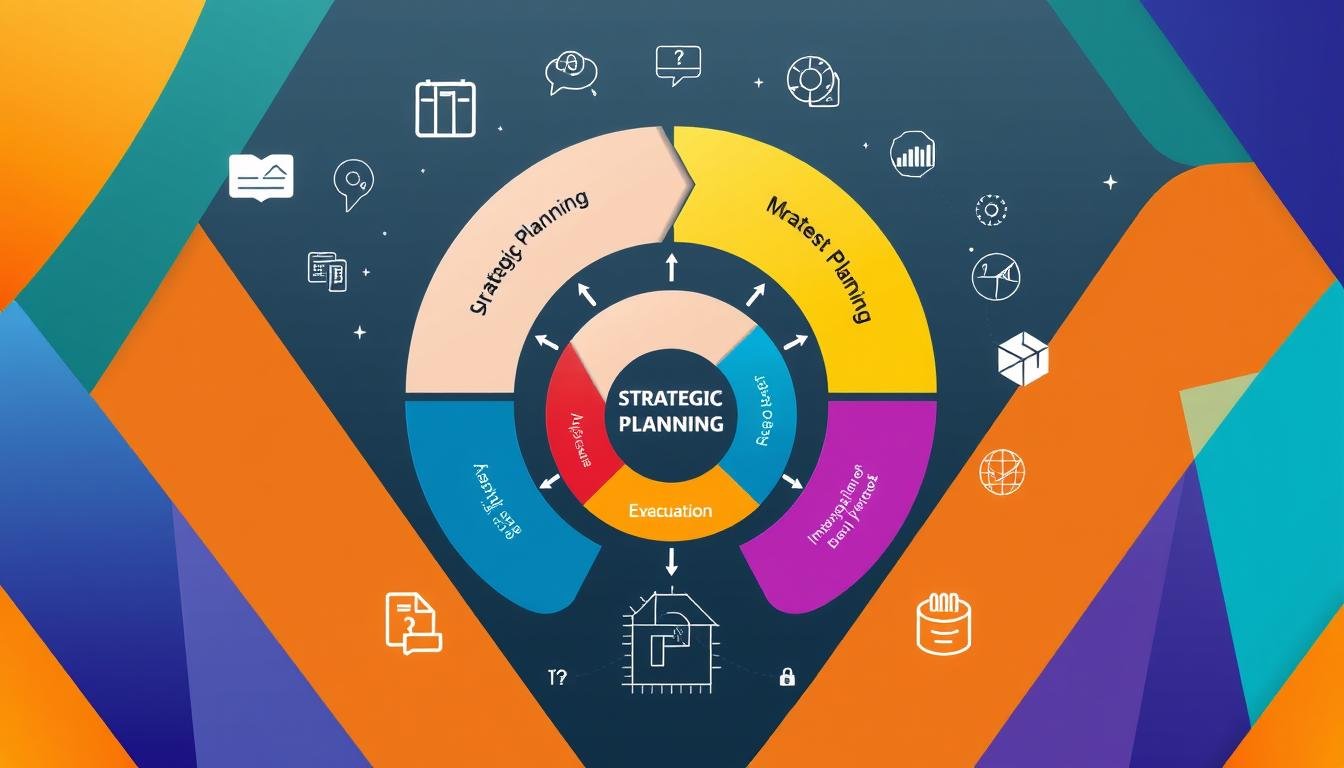Effective Strategic Planning Framework Insights
Have you ever thought about why almost 90% of employees don’t know their company’s strategy? A Harvard Business Review study found this out. It shows that many think effective strategic planning is shared well, but it’s not always the case. A good Strategic Planning Framework is key to aligning and engaging the team with goals.
It helps make clear plans for making strategic decisions. This way, companies can face their unique challenges and meet their long-term goals. Frameworks like SWOT analysis and the Balanced Scorecard help adapt to market changes. But, just having a framework isn’t enough. It must be used right and include stakeholder views.
This article will look at different parts and best practices of strategic planning frameworks. These can boost your organization’s performance and lead to lasting success.
Key Takeaways
- Only 1 in 4 employees see a clear connection between their work and company strategy.
- Effective strategic planning frameworks enhance engagement and performance.
- Common tools like SWOT analysis and the Balanced Scorecard are widely utilized by organizations.
- Successful frameworks promote stakeholder involvement and continuous adaptation.
- A blended approach to various models can sharpen focus and navigate complexities.
Understanding the Importance of Strategic Planning
Strategic planning is key to guiding organizations towards their future goals. It helps make decisions in a structured way, aligning with a big vision. This process sets clear goals and makes sure resources are used well to achieve them.
The Role of Strategic Planning in Organizational Success
Organizations that plan strategically are better at handling big changes. When key people like managers and partners help plan, success is more likely. For example, yearly planning sessions help update goals and solve new problems.
Having a strategic planning consultant can make things smoother. They offer expert advice that helps understand the organization’s goals.
Benefits of Effective Strategic Planning Frameworks
Good strategic planning frameworks bring many benefits for long-term success. They help in:
- Enhancing operational efficiency by giving a clear plan for goals.
- Promoting transparency and teamwork, building trust in the organization.
- Encouraging a proactive mindset to spot chances and avoid risks early.
- Boosting staff happiness and keeping them around through better work culture and career growth.
- Matching the mission of smaller groups with big goals, especially in healthcare.
Using strategic planning frameworks helps organizations work better together, making sure everyone knows the goals. These frameworks help make smart decisions, improve the work environment, and give a competitive edge in a changing world.
| Benefits | Description |
|---|---|
| Operational Efficiency | Provides a clear pathway to achieve strategic goals and align functional activities. |
| Stakeholder Collaboration | Builds trust and manages expectations among organizational leaders and employees. |
| Proactivity | Empowers organizations to address potential issues before they escalate into crises. |
| Employee Satisfaction | Enhances retention rates through strategic initiatives and improved workplace culture. |
| Alignment with Larger Goals | Ensures smaller entities collaborate effectively with broader organizational objectives. |
Components of an Effective Strategic Planning Framework
An effective strategic planning framework has many parts that work together. They give an organization clear direction and purpose. Each part is important, making sure the organization knows its vision, mission, goals, and tracks its progress.
Vision and Mission Statements
Strong vision and mission statements are key to any strategic framework. They tell what the organization wants to achieve in the long run. For example, Warby Parker aims to make buying glasses easy and also help others. This keeps the company focused on its main goals.
Goal Setting and Objectives
Setting clear goals is key to making the vision real. Goals are specific, measurable, achievable, relevant, and time-bound (SMART). This helps teams know what to focus on. Warby Parker sets goals in areas like customer experience and innovation. This way, they can see how well they’re doing.
Monitoring and Evaluation Techniques
It’s important to check on strategic plans to see how they’re doing. Tools like balanced scorecards and SWOT analysis help spot strengths, weaknesses, opportunities, and threats. This helps make changes quickly and stay on track towards goals.
| Component | Description | Example Tools |
|---|---|---|
| Vision and Mission | Outlines the organization’s purpose and long-term aspirations | Vision Statements, Mission Statements |
| Goal Setting | Defines specific and measurable objectives that guide action | SMART Criteria, Objectives and Key Results (OKRs) |
| Monitoring | Tracks progress towards goals, identifying areas for improvement | Balanced Scorecard, SWOT Analysis |
Exploring Popular Strategic Planning Models
Organizations use different strategic planning models to improve their planning and set clear goals. The Balanced Scorecard model and the SWOT analysis are key for making a strong strategy. PEST analysis helps understand the outside world that companies work in. Each model has its own benefits that help companies do better.
Balanced Scorecard Model
The Balanced Scorecard model helps turn goals into steps you can take. It looks at performance from four angles: finance, customers, how things work inside, and learning and growth. This way, companies get a full picture of how they’re doing. They make sure they hit both short and long-term goals.
SWOT Analysis as a Planning Tool
SWOT analysis is a key tool for looking at what’s strong and weak inside a company and what’s happening outside. It helps companies use their strengths, fix weaknesses, grab chances, and dodge threats. Doing a SWOT analysis often keeps companies ready and quick to adapt to market changes.
PEST Analysis for Environmental Scanning
PEST analysis looks at big things outside that affect a company’s strategy. It covers Political, Economic, Social, and Technological factors. By looking at these, companies can spot trends and changes that might affect them. Using PEST analysis in planning helps companies stay on top of big factors that shape their business.
| Model | Focus Area | Primary Benefit |
|---|---|---|
| Balanced Scorecard | Performance Measurement | Comprehensive view of strategic objectives |
| SWOT Analysis | Internal and External Assessment | Strategic positioning and insights |
| PEST Analysis | External Environment | Awareness of macro factors influencing strategy |
Strategic Planning Framework: Best Practices
Using best practices in strategic planning helps organizations align their plans with big goals. This is key for using resources well and working better overall.
Aligning Strategy with Organizational Goals
Aligning strategy means making a plan that ties all initiatives to the company’s mission and vision. First, set long-term goals and specific, measurable targets that match the company’s values. A strategic plan outlines how to use resources to reach from where we are to where we want to be.
Incorporating Stakeholder Input
Getting input from stakeholders makes people feel they own the plan and brings different ideas. This can lead to more creative solutions and new insights. By listening to everyone, companies make sure everyone supports the plan and it’s more likely to work.
Continuous Improvement and Adaptation
Keeping plans up to date is key for staying ahead. Regularly checking and updating plans helps adapt to new situations, market changes, and what stakeholders want. Tools like the Balanced Scorecard or OKRs help with this, making sure plans stay relevant and effective.
| Best Practice | Description |
|---|---|
| Goal Alignment | Develop objectives that directly support the mission and vision of the organization. |
| Stakeholder Engagement | Include input from all relevant stakeholders to promote buy-in and collaboration. |
| Resource Allocation | Prioritize resources towards key objectives to ensure strategic focus. |
| Regular Reviews | Continuously assess and adapt strategies based on internal and external feedback. |
| Performance Metrics | Establish clear metrics to measure progress and outcomes against goals. |
Implementing Your Strategic Planning Framework
Implementing a strategic planning framework means following steps and using the right tools. It helps organizations stay on track with their goals. By focusing on key actions and using effective planning tools, the process gets easier and more unified.
Steps for Successful Implementation
First, define your organization’s vision and mission. This sets the stage for everything that follows. Then, look at what you’re good at and what you’re not, and see what opportunities and threats you face. This helps you set goals, which is key to making a strategy.
Using tools like Balanced Scorecards can help with this. Next, build a structure that matches your strategic goals. Finally, keep an eye on how well you’re doing by tracking key performance indicators (KPIs).
- Define your organizational vision and mission.
- Conduct a thorough analysis of internal and external factors.
- Set specific, measurable goals aligned with the strategy.
- Establish an effective organizational structure.
- Monitor progress through relevant key performance indicators (KPIs).
Utilizing Strategic Planning Tools and Templates
Using the right tools and templates can make implementing your strategic plan easier. These tools help you document your strategy and keep track of progress. Keeping an eye on KPIs helps you stay on track, and regular meetings let you adjust as needed.
It’s a good idea to focus on just 1-3 KPIs for each strategic goal. This keeps things clear and focused.
| Tool/Template | Purpose | Benefits |
|---|---|---|
| Balanced Scorecard | Aligns business activities to vision and strategy | Enhances communication and performance measurement |
| SWOT Analysis | Identifies strengths, weaknesses, opportunities, threats | Supports strategic decision-making and priorities |
| Gantt Chart | Visualizes project timelines and responsibilities | Improves project management and accountability |
| SMART Goals Template | Defines specific, measurable, achievable, relevant, time-bound goals | Increases focus and clarity in goal setting |
Conclusion
Effective strategic planning is key for guiding organizations towards their goals. It starts with a bold vision and clear, measurable goals. These goals must match the organization’s mission and values.
Using stakeholder input and ongoing evaluation helps improve strategies. This way, organizations can adapt to changes in the business world.
The future of strategic planning will focus more on new strategies like AI and big data. These tools help make decisions based on data. Companies like Amazon and Netflix show how important it is to be adaptable and responsive to market changes.
Also, looking at competitors and understanding customers helps businesses know their strengths and weaknesses. This ensures they can use opportunities and face challenges well.
Strategic planning is not just about setting goals. It’s about growing and being resilient. Regularly checking and updating plans helps companies stay ahead. This leads to better value for stakeholders, happy employees, and success over time.
Source Links
- Key Frameworks of Strategic Planning: SWOT, PESTEL, and More
- 11 Best Strategic Frameworks For Your Organization
- Comparison of Strategic Planning Frameworks
- Strategic Planning: Why It Makes a Difference, and How to Do It
- 5 Benefits of Strategic Planning
- 8 Strategic Planning Frameworks to Achieve Your Goals
- 20 Essential Strategic Frameworks for Effective Management
- 6 Elements of Effective Strategic Planning
- 7 Strategic Planning Models and 8 Frameworks To Start [2024] • Asana
- Strategic Planning Frameworks and Models | Smartsheet
- Strategic Planning Process: 7 Crucial Steps to Success
- 20 top strategic planning tools and frameworks [templates & examples] | Mural
- The Strategic Management Framework: A Simple Look – The World of Work Project
- 5 tips for implementing your strategic plan
- Strategy Implementation: The 6 Step Process
- The Strategic Planning Process in 4 Steps | OnStrategy
- What is Strategic Planning and Why is it Important in Business?
- The 5 steps of the strategic planning process | Mural







